Advancements in Optimal Sensor Placement for Enhanced Structural Health Monitoring: Current Insights and Future Prospects
Abstract
:1. Introduction
- The system should be as well constructed as possible at a low cost.
- The system is robust for continuous operation.
- The system can easily obtain and store large amounts of data for analysis.
- The system is sensitive to the vibration information of the structure and insensitive to noise.
- Determining monitoring objectives according to the structural application.
- Determining the type of sensor which is suitable according to the monitoring objective.
- Determining parameters such as the number of sensors and the candidate locations of sensors.
- Determining evaluation criteria for the optimal placement of sensors.
- Determining the optimization algorithm for the optimal arrangement of sensors.
- Determining the cost function and the input parameters for the optimization algorithm.
- Determining the optimal solution for the sensor placement employing numerous calculations.
2. Evaluation Criteria
2.1. Maximum Vibration Signal
2.1.1. Modal Kinetic Energy (MKE)
2.1.2. Mode Shape Summation Plot (MSSP)
2.1.3. Eigenvector Component Product (ECP)
2.1.4. Driving Point Residue (DPR)
2.2. Maximum Modal Identification
2.2.1. Modal Assurance Criterion (MAC)
2.2.2. Redundancy of Mode Shape (RMS)
2.2.3. Singular Value Decomposition Ratio (SVDR)
2.3. Minimum Parameter Identification Error
2.3.1. Fisher Information Matrix (FIM)
2.3.2. Information Entropy (IE)
2.3.3. Mutual Information (MI)
2.4. Data Reconstruction Error Minimization
2.5. Probability-Based Damage Detection
2.6. Minimum Energy Consumption
2.7. Others
2.7.1. Cost
2.7.2. Coverage
2.8. Summary of the Section
3. Optimization Methods
3.1. Deterministic Sensor Placement Algorithm
3.2. Sequential Sensor Placement Algorithm
3.3. Meta-Heuristic Optimization Algorithm
3.3.1. Genetic Algorithm (GA)
3.3.2. Particle Swarm Optimization (PSO)
3.3.3. Others
3.4. Summary of the Section
4. Engineering Applications
4.1. Bridges
4.2. High-Rise Buildings
4.3. Others
4.4. Summary of the Section
5. Challenges and Prospects
5.1. Challenges
5.1.1. Interplay of Sensor Placement Sensing Techniques and Data Processing
5.1.2. The Bottleneck of Optimization Algorithms
5.1.3. Discrepancy between Research Advancements and Practical Applications
5.2. Prospects
5.2.1. Optimal Sensor Placement under Uncertainty
5.2.2. Optimal Arrangement of Different Types of Sensors
5.2.3. Optimal Sensor Placement under Multiple Objectives
5.2.4. Optimal Sensor Placement with Emerging Technology
6. Conclusions
Author Contributions
Funding
Data Availability Statement
Conflicts of Interest
References
- Omrany, H.; Ghaffarianhoseini, A.; Chang, R.D.; Ghaffarianhoseini, A.; Rahimian, F.P. Applications of Building information modelling in the early design stage of high-rise buildings. Autom. Constr. 2023, 152, 104934. [Google Scholar] [CrossRef]
- Ni, F.T.; Zhang, J.; Noori, M.N. Deep learning for data anomaly detection and data compression of a long-span suspension bridge. Comput. Aided Civ. Infrastruct. Eng. 2020, 35, 685–700. [Google Scholar] [CrossRef]
- Zhang, Y.M.; Wang, H.; Mao, J.X.; Xu, Z.D.; Zhang, Y.F. Probabilistic Framework with Bayesian Optimization Responses of a Long-Span Bridge. J. Struct. Eng. 2021, 147, 04020297. [Google Scholar] [CrossRef]
- Xie, Z.H.; Xie, F.G.; Zhu, L.M.; Liu, X.J. Robotic mobile and mirror milling of large-scale complex structures. Natl. Sci. Rev. 2023, 10, nwac188. [Google Scholar] [CrossRef] [PubMed]
- Yang, C. Advances and prospects for optimal sensor placement of structural health monitoring. J. Vib. Shock. 2020, 39, 82–93. [Google Scholar]
- Tan, Y.; Zhang, L. Computational methodologies for optimal sensor placement in structural health monitoring: A review. Struct. Health Monit. 2019, 19, 1287–1308. [Google Scholar] [CrossRef]
- Housner, G.W.; Bergman, L.A.; Caughey, T.K.; Chassiakos, A.G.; Claus, R.O.; Masri, S.F.; Skelton, R.E.; Soong, T.T.; Spencer, B.F.; Yao, J.T.P. Structural control: Past, present, and future. J. Eng. Mech. 1997, 123, 897–971. [Google Scholar] [CrossRef]
- Yi, T.H.; Li, H.N. Methodology Developments in Sensor Placement for Health Monitoring of Civil Infrastructures. Int. J. Distrib. Sens. Netw. 2012, 11, 612726. [Google Scholar] [CrossRef]
- Ostachowicz, W.; Soman, R.; Malinowski, P. Optimization of sensor placement for structural health monitoring: A review. Struct. Health Monit. 2019, 18, 963–988. [Google Scholar] [CrossRef]
- Li, D.; Zhang, Y.; Ren, L.; Li, H. Sensor deployment for structural health monitoring and their evaluation. Adv. Mech. 2011, 41, 39–50. [Google Scholar]
- Hernandez, E.M. Efficient sensor placement for state estimation in structural dynamics. Mech. Syst. Signal Proc. 2017, 85, 789–800. [Google Scholar] [CrossRef]
- Leyder, C.; Dertimanis, V.; Frangi, A.; Chatzi, E.; Lombaert, G. Optimal sensor placement methods and metrics—Comparison and implementation on a timber frame structure. Struct. Infrastruct. Eng. 2018, 14, 997–1010. [Google Scholar] [CrossRef]
- Lee, E.T.; Eun, H.C. An Optimal Sensor Layout Using the Frequency Response Function Data within a Wide Range of Frequencies. Sensors 2022, 22, 3778. [Google Scholar] [CrossRef] [PubMed]
- Lam, H.-F.; Adeagbo, M.O. An enhanced sequential sensor optimization scheme and its application in the system identification of a rail-sleeper-ballast system. Mech. Syst. Signal Proc. 2022, 163, 108188. [Google Scholar] [CrossRef]
- Cantero-Chinchilla, S.; Papadimitriou, C.; Chiachío, J.; Chiachío, M.; Koumoutsakos, P.; Fabro, A.T.; Chronopoulos, D. Robust optimal sensor configuration using the value of information. Struct. Control Health Monit. 2022, 29, e3143. [Google Scholar] [CrossRef]
- Loutas, T.H.; Bourikas, A. Strain sensors optimal placement for vibration-based structural health monitoring. The effect of damage on the initially optimal configuration. J. Sound. Vib. 2017, 410, 217–230. [Google Scholar] [CrossRef]
- Yang, C. An adaptive sensor placement algorithm for structural health monitoring based on multi-objective iterative optimization using weight factor updating. Mech. Syst. Signal Proc. 2021, 151, 107363. [Google Scholar] [CrossRef]
- Lin, J.-F.; Xu, Y.-L. Response covariance-based sensor placement for structural damage detection. Struct. Infrastruct. Eng. 2017, 14, 1207–1220. [Google Scholar] [CrossRef]
- Yang, C.; Lu, Z. An interval effective independence method for optimal sensor placement based on non-probabilistic approach. Sci. China Technol. Sci. 2016, 60, 186–198. [Google Scholar] [CrossRef]
- Bertola, N.J.; Smith, I.F.C. A methodology for measurement-system design combining information from static and dynamic excitations for bridge load testing. J. Sound. Vib. 2019, 463, 114953. [Google Scholar] [CrossRef]
- Kim, T.; Youn, B.D.; Oh, H. Development of a stochastic effective independence (SEFI) method for optimal sensor placement under uncertainty. Mech. Syst. Signal Proc. 2018, 111, 615–627. [Google Scholar] [CrossRef]
- Zhang, Y.; Chai, S.; An, C.; Lim, F.; Duan, M. A new method for optimal sensor placement considering multiple factors and its application to deepwater riser monitoring systems. Ocean. Eng. 2022, 244, 110403. [Google Scholar] [CrossRef]
- Downey, A.; Hu, C.; Laflamme, S. Optimal sensor placement within a hybrid dense sensor network using an adaptive genetic algorithm with learning gene pool. Struct. Health Monit. 2017, 17, 450–460. [Google Scholar] [CrossRef]
- Yang, C.; Lu, Z.; Yang, Z. Robust Optimal Sensor Placement for Uncertain Structures with Interval Parameters. IEEE Sens. J. 2018, 18, 2031–2041. [Google Scholar] [CrossRef]
- Yi, T.H.; Zhou, G.D.; Li, H.N.; Wang, C.W. Optimal placement of triaxial sensors for modal identification using hierarchic wolf algorithm. Struct. Control. Health Monit. 2017, 24, e1958. [Google Scholar] [CrossRef]
- Yang, C.; Zheng, W.; Zhang, X. Optimal sensor placement for spatial lattice structure based on three-dimensional redundancy elimination model. Appl. Math. Model. 2019, 66, 576–591. [Google Scholar] [CrossRef]
- Su, J.-B.; Luan, S.-L.; Zhang, L.-M.; Zhu, R.-H.; Qin, W.-G. Partitioned genetic algorithm strategy for optimal sensor placement based on structure features of a high-piled wharf. Struct. Control Health Monit. 2019, 26, e2289. [Google Scholar] [CrossRef]
- Yang, C.; Xia, Y. A novel two-step strategy of non-probabilistic multi-objective optimization for load-dependent sensor placement with interval uncertainties. Mech. Syst. Signal Proc. 2022, 176, 109173. [Google Scholar] [CrossRef]
- Colombo, L.; Todd, M.D.; Sbarufatti, C.; Giglio, M. On statistical Multi-Objective optimization of sensor networks and optimal detector derivation for structural health monitoring. Mech. Syst. Signal Proc. 2022, 167, 108528. [Google Scholar] [CrossRef]
- Yuen, K.V.; Hao, X.H.; Kuok, S.C. Robust sensor placement for structural identification. Struct. Control. Health Monit. 2022, 29, e2861. [Google Scholar] [CrossRef]
- Shi, Q.; Wang, H.; Wang, L.; Luo, Z.; Wang, X.; Han, W. A bilayer optimization strategy of optimal sensor placement for parameter identification under uncertainty. Struct. Multidiscip. Optim. 2022, 65, 264. [Google Scholar] [CrossRef]
- Nieminen, V.; Sopanen, J. Optimal sensor placement of triaxial accelerometers for modal expansion. Mech. Syst. Signal Proc. 2023, 184, 109581. [Google Scholar] [CrossRef]
- Zhang, C.D.; Xu, Y.L. Optimal multi-type sensor placement for response and excitation reconstruction. J. Sound. Vib. 2016, 360, 112–128. [Google Scholar] [CrossRef]
- Mendler, A.; Döhler, M.; Ventura, C.E. Sensor placement with optimal damage detectability for statistical damage detection. Mech. Syst. Signal Proc. 2022, 170, 108767. [Google Scholar] [CrossRef]
- Zhang, C.; Zhou, Z.; Hu, G.; Yang, L.; Tang, S. Health assessment of the wharf based on evidential reasoning rule considering optimal sensor placement. Measurement 2021, 186, 110184. [Google Scholar] [CrossRef]
- Dinh-Cong, D.; Dang-Trung, H.; Nguyen-Thoi, T. An efficient approach for optimal sensor placement and damage identification in laminated composite structures. Adv. Eng. Softw. 2018, 119, 48–59. [Google Scholar] [CrossRef]
- Chisari, C.; Macorini, L.; Amadio, C.; Izzuddin, B.A. Optimal sensor placement for structural parameter identification. Struct. Multidiscip. Optim. 2016, 55, 647–662. [Google Scholar] [CrossRef]
- Huang, Y.; Ludwig, S.A.; Deng, F. Sensor optimization using a genetic algorithm for structural health monitoring in harsh environments. J. Civ. Struct. Health Monit. 2016, 6, 509–519. [Google Scholar] [CrossRef]
- Lin, C.; Zhang, C.-l.; Chen, J.-h. Optimal arrangement of structural sensors in soft rock tunnels based industrial IoT applications. Comput. Commun. 2020, 156, 159–167. [Google Scholar] [CrossRef]
- Keskin, M.E. A column generation heuristic for optimal wireless sensor network design with mobile sinks. Eur. J. Oper. Res. 2017, 260, 291–304. [Google Scholar] [CrossRef]
- Kaveh, A.; Dadras Eslamlou, A.; Rahmani, P.; Amirsoleimani, P. Optimal sensor placement in large-scale dome trusses via Q-learning-based water strider algorithm. Struct. Control Health Monit. 2022, 29, e2949. [Google Scholar] [CrossRef]
- Zhou, S.; Yu, L.; Wu, Z.; Yang, H. Optimal Sensor Placement Based on Deep Learning Method. J. Vib. Meas. Diagn. 2020, 40, 719–724. [Google Scholar]
- Salama, M.; Rose, T.; Garba, J. Optimal placement of excitations and sensors for verification of large dynamical systems. In Proceedings of the 28th Structures, Structural Dynamics and Materials Conference, Monterey, CA, USA, 6–8 April 1987. [Google Scholar]
- Stubbs, N.; Kim, J.T. Damage localization in structures without baseline modal parameters. Aiaa J. 1996, 34, 1644–1649. [Google Scholar] [CrossRef]
- Kim, J.T.; Ryu, Y.S.; Cho, H.M.; Stubbs, N. Damage identification in beam-type structures: Frequency-based method vs mode-shape-based method. Eng. Struct. 2003, 25, 57–67. [Google Scholar] [CrossRef]
- He, C.; Xing, J.; Li, J.; Yang, Q.; Wang, R.; Zhang, X. A Combined Optimal Sensor Placement Strategy for the Structural Health Monitoring of Bridge Structures. Int. J. Distrib. Sens. Netw. 2013, 9, 820694. [Google Scholar] [CrossRef]
- Declerck, J.P.; Avitabile, P. Development of Several New Tools for Modal Pre-test Evaluation. In Proceedings of the 14th International Modal Analysis Conference, Dearborn, MI, USA, 12–15 February 1996; p. 1272. [Google Scholar]
- Horn, R.A.; Johnson, C.R. Matrix Analysis; Cambridge University Press: Cambridge, UK, 2012. [Google Scholar]
- Gui, C.; Lei, J.; Duan, Z.; Zhang, X. Optimal sensor placement by using MSSP/DM-MAC method. Chin. J. Appl. Mech. 2019, 36, 1499–1503. [Google Scholar]
- Heylen, W.; Lammens, S.; Sas, P. Modal Analysis Theory and Testing; Katholieke Universiteit Leuven: Leuven, Belgium, 1997; Volume 200. [Google Scholar]
- Larson, C.B.; Zimmerman, D.C.; Marek, E.L. A comparison of modal test planning techniques: Excitation and sensor placement using the NASA 8-bay truss. In Proceedings of the 12th International Modal Analysis Conference, Ilikai Hotel, Honolulu, HI, USA, 31 January–3 February 1994; Volume 2251, p. 205. [Google Scholar]
- Imamovic, N.; Ewins, D. Optimization of excitation DOF selection for modal tests. In Proceedings of the 15th International Modal Analysis Conference, Orlando, FL, USA, 3–6 February 1997; p. 1945. [Google Scholar]
- Imamovic, N. Validation of Large Structural dynamics MODELS Using Modal Test Data. Doctoral Dissertation, Department of Mechanical Engineering, Imperial College, London, UK, 1998. [Google Scholar]
- Meo, M.; Zumpano, G. On the optimal sensor placement techniques for a bridge structure. Eng. Struct. 2005, 27, 1488–1497. [Google Scholar] [CrossRef]
- Carne, T.G.; Dohrmann, C.R. A modal test design strategy for model correlation. In Proceedings of the Conference: International Modal Analysis Conference, Nashville, TN, USA, 13–16 February 1995. [Google Scholar]
- An, H.; Youn, B.D.; Kim, H.S. A methodology for sensor number and placement optimization for vibration-based damage detection of composite structures under model uncertainty. Compos. Struct. 2022, 279, 114863. [Google Scholar] [CrossRef]
- Stephan, C. Sensor placement for modal identification. Mech. Syst. Signal Proc. 2012, 27, 461–470. [Google Scholar] [CrossRef]
- Lin, T.Y.; Tao, J.; Huang, H.H. A Multiobjective Perspective to Optimal Sensor Placement by Using a Decomposition-Based Evolutionary Algorithm in Structural Health Monitoring. Appl. Sci. 2020, 10, 7710. [Google Scholar] [CrossRef]
- Golub, G.H.; Van Loan, C.F. Matrix Computations; JHU Press: Baltimore, MD, USA, 2013. [Google Scholar]
- Cherng, A.P. Optimal sensor placement for modal parameter identification using signal subspace correlation techniques. Mech. Syst. Signal Proc. 2003, 17, 361–378. [Google Scholar] [CrossRef]
- Chhabra, D.; Bhushan, G.; Chandna, P. Optimal placement of piezoelectric actuators on plate structures for active vibration control via modified controlmatrix and singular value decomposition approach using modified heuristic genetic algorithm. Mech. Adv. Mater. Struct. 2016, 23, 272–280. [Google Scholar] [CrossRef]
- Kammer, D.C. Sensor placement for on-orbit modal identification and correlation of large space structures. J. Guid. Control Dyn. 1991, 14, 251–259. [Google Scholar] [CrossRef]
- Bayard, D.S.; Hadaegh, F.Y.; Meldrum, D.R. Optimal experiment design for identification of large space structures. Automatica 1988, 24, 357–364. [Google Scholar] [CrossRef]
- Borguet, S.; Leonard, O. The Fisher Information Matrix as a Relevant Tool for Sensor Selection in Engine Health Monitoring. Int. J. Rotating Mach. 2008, 2008, 784749. [Google Scholar] [CrossRef]
- An, H.; Youn, B.D.; Kim, H.S. Optimal Sensor Placement Considering Both Sensor Faults under Uncertainty and Sensor Clustering for Vibration-Based Damage Detection. Struct. Multidiscip. Optim. 2022, 65, 102. [Google Scholar] [CrossRef]
- Papadimitriou, C.; Beck, J.L.; Au, S.K. Entropy-based optimal sensor location for structural model updating. J. Vib. Control 2000, 6, 781–800. [Google Scholar] [CrossRef]
- Papadimitriou, C. Pareto optimal sensor locations for structural identification. Comput. Meth. Appl. Mech. Eng. 2005, 194, 1655–1673. [Google Scholar] [CrossRef]
- Papadimitriou, C. Optimal sensor placement methodology for parametric identification of structural systems. J. Sound. Vib. 2004, 278, 923–947. [Google Scholar] [CrossRef]
- Yang, Y.; Chadha, M.; Hu, Z.; Todd, M.D. An optimal sensor placement design framework for structural health monitoring using Bayes risk. Mech. Syst. Signal Proc. 2022, 168, 108618. [Google Scholar] [CrossRef]
- Bansal, S.; Cheung, S.H. On the Bayesian sensor placement for two-stage structural model updating and its validation. Mech. Syst. Signal Proc. 2022, 169, 108578. [Google Scholar] [CrossRef]
- Pei, X.-Y.; Yi, T.-H.; Qu, C.-X.; Li, H.-N. Conditional information entropy based sensor placement method considering separated model error and measurement noise. J. Sound. Vib. 2019, 449, 389–404. [Google Scholar] [CrossRef]
- Mehrjoo, A.; Song, M.; Moaveni, B.; Papadimitriou, C.; Hines, E. Optimal sensor placement for parameter estimation and virtual sensing of strains on an offshore wind turbine considering sensor installation cost. Mech. Syst. Signal Proc. 2022, 169, 108787. [Google Scholar] [CrossRef]
- Said, W.M.; Staszewski, W.J. Optimal sensor location for damage detection using mutual information. In Proceedings of the 11th International Conference on Adaptive Structures and Technologies (ICAST), Nagoya, Japan, 23–26 October 2000; pp. 428–435. [Google Scholar]
- Chen, M.J.; Sivakumar, K.; Banyay, G.A.; Golchert, B.M.; Walsh, T.F.; Zavlanos, M.M.; Aquino, W. Bayesian Optimal Sensor Placement for Damage Detection in Frequency-Domain Dynamics. J. Eng. Mech. 2022, 148, 04022078. [Google Scholar] [CrossRef]
- Bhattacharyya, P.; Beck, J. Exploiting convexification for Bayesian optimal sensor placement by maximization of mutual information. Struct. Control. Health Monit. 2020, 27, e2605. [Google Scholar] [CrossRef]
- Azam, S.E.; Chatzi, E.; Papadimitriou, C. A dual Kalman filter approach for state estimation via output-only acceleration measurements. Mech. Syst. Signal Proc. 2015, 60–61, 866–886. [Google Scholar] [CrossRef]
- O’Callahan, J.C. System equivalent reduction expansion process. In Proceedings of the 7th International Modal Analysis Conference, Las Vegas, NV, USA, 30 January–2 February 1989. [Google Scholar]
- O’Callahan, J.; Li, P. A non smoothing SEREP process for modal expansion. In Proceedings of the 12th International Modal Analysis Conference, Ilikai Hotel, Honolulu, HI, USA, 31 January–3 February 1994; Volume 2251, p. 232. [Google Scholar]
- Guyan, R.J. Reduction of stiffness and mass matrices. Aiaa J. 1965, 3, 380. [Google Scholar] [CrossRef]
- Lin, J.F.; Xu, Y.L.; Law, S.S. Structural damage detection-oriented multi-type sensor placement with multi-objective optimization. J. Sound. Vib. 2018, 422, 568–589. [Google Scholar] [CrossRef]
- Nasr, D.; Dahr, R.E.; Assaad, J.; Khatib, J. Comparative Analysis between Genetic Algorithm and Simulated Annealing-Based Frameworks for Optimal Sensor Placement and Structural Health Monitoring Purposes. Buildings 2022, 12, 1383. [Google Scholar] [CrossRef]
- Jaya, M.M.; Ceravolo, R.; Fragonara, L.Z.; Matta, E. An optimal sensor placement strategy for reliable expansion of mode shapes under measurement noise and modelling error. J. Sound. Vib. 2020, 487, 115511. [Google Scholar] [CrossRef]
- Cumbo, R.; Tamarozzi, T.; Janssens, K.; Desmet, W. Kalman-based load identification and full-field estimation analysis on industrial test case. Mech. Syst. Signal Proc. 2019, 117, 771–785. [Google Scholar] [CrossRef]
- Warsewa, A.; Bohm, M.; Guerra, F.; Wagner, J.L.; Haist, T.; Tarin, C.; Sawodny, O. Self-tuning state estimation for adaptive truss structures using strain gauges and camera-based position measurements. Mech. Syst. Signal Proc. 2020, 143, 106822. [Google Scholar] [CrossRef]
- Flynn, E.B.; Todd, M.D. A Bayesian approach to optimal sensor placement for structural health monitoring with application to active sensing. Mech. Syst. Signal Proc. 2010, 24, 891–903. [Google Scholar] [CrossRef]
- Rucevskis, S.; Rogala, T.; Katunin, A. Optimal Sensor Placement for Modal-Based Health Monitoring of a Composite Structure. Sensors 2022, 22, 3867. [Google Scholar] [CrossRef] [PubMed]
- Hou, R.R.; Xia, Y.; Xia, Q.; Zhou, X.Q. Genetic algorithm based optimal sensor placement for L-1-regularized damage detection. Struct. Control. Health Monit. 2019, 26, e2274. [Google Scholar] [CrossRef]
- Zhou, G.D.; Yi, T.H.; Zhang, H.; Li, H.N. Energy-aware wireless sensor placement in structural health monitoring using hybrid discrete firefly algorithm. Struct. Control. Health Monit. 2015, 22, 648–666. [Google Scholar] [CrossRef]
- Elsersy, M.; Elfouly, T.M.; Ahmed, M.H. Joint Optimal Placement, Routing, and Flow Assignment in Wireless Sensor Networks for Structural Health Monitoring. IEEE Sens. J. 2016, 16, 5095–5106. [Google Scholar] [CrossRef]
- Liu, Y.; Chin, K.W.; Yang, C.L.; He, T.J. Nodes Deployment for Coverage in Rechargeable Wireless Sensor Networks. IEEE Trans. Veh. Technol. 2019, 68, 6064–6073. [Google Scholar] [CrossRef]
- Tam, N.T.; Binh, H.T.T.; Dat, V.T.; Lan, P.N.; Vinh, L.T. Towards optimal wireless sensor network lifetime in three dimensional terrains using relay placement metaheuristics. Knowl.-Based Syst. 2020, 206, 106407. [Google Scholar] [CrossRef]
- Yuan, B.; Chen, H.H.; Yao, X. Optimal relay placement for lifetime maximization in wireless underground sensor networks. Inf. Sci. 2017, 418, 463–479. [Google Scholar] [CrossRef]
- Hao, X.H.; Yuen, K.V.; Kuok, S.C. Energy-aware versatile wireless sensor network configuration for structural health monitoring. Struct. Control. Health Monit. 2022, 29, e3083. [Google Scholar] [CrossRef]
- Xenakis, A.; Foukalas, F.; Stamoulis, G. Cross-layer energy-aware topology control through Simulated Annealing for WSNs. Comput. Electr. Eng. 2016, 56, 576–590. [Google Scholar] [CrossRef]
- Fang, K.; Liu, C.Y.; Teng, J. Cluster-based optimal wireless sensor deployment for structural health monitoring. Struct. Health Monit. 2018, 17, 266–278. [Google Scholar] [CrossRef]
- Juhlin, M.; Jakobsson, A. Optimal sensor placement for localizing structured signal sources. Signal Process. 2023, 202, 108679. [Google Scholar] [CrossRef]
- Dhillon, S.S.; Chakrabarty, K. Sensor placement for effective coverage and surveillance in distributed sensor networks. In Proceedings of the 2003 IEEE Wireless Communications and Networking, WCNC 2003, New Orleans, LA, USA, 16–20 March 2003; Volume 1603, pp. 1609–1614. [Google Scholar]
- Maulin, P.; Chandrasekaran, R.; Venkatesan, S. Energy efficient sensor, relay and base station placements for coverage, connectivity and routing. In Proceedings of the PCCC 2005, 24th IEEE International Performance, Computing, and Communications Conference, Phoenix, AZ, USA, 7–9 April 2005; pp. 581–586. [Google Scholar]
- Wang, B. Coverage problems in sensor networks: A survey. ACM Comput. Surv. 2011, 43, 32. [Google Scholar] [CrossRef]
- Wu, H.; Liu, Z.; Hu, J.; Yin, W. Sensor placement optimization for critical-grid coverage problem of indoor positioning. Int. J. Distrib. Sens. Netw. 2020, 16. [Google Scholar] [CrossRef]
- Akbarzadeh, V.; Lévesque, J.C.; Gagné, C.; Parizeau, M. Efficient sensor placement optimization using gradient descent and probabilistic coverage. Sensors 2014, 14, 15525–15552. [Google Scholar] [CrossRef]
- Thiene, M.; Khodaei, Z.S.; Aliabadi, M.H. Optimal sensor placement for maximum area coverage (MAC) for damage localization in composite structures. Smart Mater. Struct. 2016, 25, 095037. [Google Scholar] [CrossRef]
- Liu, J.; Ouyang, H.; Han, X.; Liu, G.R. Optimal sensor placement for uncertain inverse problem of structural parameter estimation. Mech. Syst. Signal Proc. 2021, 160, 107914. [Google Scholar] [CrossRef]
- Sadhu, A.; Goli, G. Blind source separation-based optimum sensor placement strategy for structures. J. Civ. Struct. Health Monit. 2017, 7, 445–458. [Google Scholar] [CrossRef]
- Biswal, S.; Wang, Y. Optimal sensor placement strategy for the identification of local bolted connection failures in steel structures. In Proceedings of the International Conference on Smart Infrastructure and Construction 2019 (ICSIC), 2019 Churchill College, Cambridge, UK, 8–10 July 2019. [Google Scholar]
- Shi, Q.H.; Wang, X.J.; Chen, W.P.; Hu, K.J. Optimal Sensor Placement Method Considering the Importance of Structural Performance Degradation for the Allowable Loadings for Damage Identification. Appl. Math. Model. 2020, 86, 384–403. [Google Scholar] [CrossRef]
- Ghosh, D.; Mukhopadhyay, S. Fisher information-based optimal sensor locations for output-only structural identification under base excitation. Struct. Control. Health Monit. 2022, 29, e3021. [Google Scholar] [CrossRef]
- Luenberger, D.G.; Ye, Y. Linear and Nonlinear Programming; Springer: Reading, MA, USA, 1984; Volume 2. [Google Scholar]
- Deuflhard, P. Newton Methods for Nonlinear Problems: Affine Invariance and Adaptive Algorithms; Springer Science & Business Media: New York, NY, USA, 2005; Volume 35. [Google Scholar]
- Sepulveda, A.E.; Jin, I.M.; Schmit, L.A. Optimal placement of active elements in control augmented structural synthesis. Aiaa J. 1993, 31, 1906–1915. [Google Scholar] [CrossRef]
- Cruz, A.; Velez, W.; Thomson, P. Optimal sensor placement for modal identification of structures using genetic algorithms-a case study: The olympic stadium in Cali, Colombia. Ann. Oper. Res. 2010, 181, 769–781. [Google Scholar] [CrossRef]
- Li, D.-S.; Fritzen, C.-P.; Li, H.-N. Extended MinMAC algorithm and comparison of sensor placement methods. In Proceedings of the IMAC-XXVI, Orlando, FL, USA, 4–7 February 2008. [Google Scholar]
- Holland, J.H. Adaptation in Natural and Artificial Systems: An Introductory Analysis with Applications to Biology, Control, and Artificial Intelligence; MIT Press: Cambridge, MA, USA, 1992. [Google Scholar]
- Zhou, K.; Wu, Z.Y. Strain gauge placement optimization for structural performance assessment. Eng. Struct. 2017, 141, 184–197. [Google Scholar] [CrossRef]
- Cazzulani, G.; Chieppi, M.; Colombo, A.; Pennacchi, P. Optimal sensor placement for continuous optical fiber sensors. In Proceedings of the Conference on Sensors and Smart Structures Technologies for Civil, Mechanical, and Aerospace Systems, Denver, CA, USA, 5–8 March 2018. [Google Scholar]
- Rao, A.R.M.; Anandakumar, G. Optimal placement of sensors for structural system identification and health monitoring using a hybrid swarm intelligence technique. Smart Mater. Struct. 2007, 16, 2658–2672. [Google Scholar] [CrossRef]
- Overton, G.; Worden, K. Sensor optimisation using an ant colony metaphor. Strain 2004, 40, 59–65. [Google Scholar] [CrossRef]
- Scott, M.; Worden, K. A Bee Swarm Algorithm for Optimising Sensor Distributions for Impact Detection on a Composite Panel. Strain 2015, 51, 147–155. [Google Scholar] [CrossRef]
- Yi, T.H.; Li, H.N.; Zhang, X.D. Health monitoring sensor placement optimization for Canton Tower using immune monkey algorithm. Struct. Control. Health Monit. 2015, 22, 123–138. [Google Scholar] [CrossRef]
- Zhou, G.-D.; Yi, T.-H.; Li, H.-N. Sensor placement optimization in structural health monitoring using cluster-in-cluster firefly algorithm. Adv. Struct. Eng. 2014, 17, 1103–1115. [Google Scholar] [CrossRef]
- Gao, H.D.; Rose, J.L. Sensor placement optimization in structural health monitoring using genetic and evolutionary algorithms. In Proceedings of the Smart Structures and Materials 2006 Conference, San Diego, CA, USA, 27 February–2 March 2006. [Google Scholar]
- Yi, T.H.; Li, H.N.; Gu, M. Optimal Sensor Placement for Health Monitoring of High-Rise Structure Based on Genetic Algorithm. Math. Probl. Eng. 2011, 2011, 395101. [Google Scholar] [CrossRef]
- Roy, T.; Chakraborty, D. Optimal vibration control of smart fiber reinforced composite shell structures using improved genetic algorithm. J. Sound. Vib. 2009, 319, 15–40. [Google Scholar] [CrossRef]
- Zhang, H.W.; Lennox, B.; Goulding, P.R.; Leung, A.Y.T. A float-encoded genetic algorithm technique for integrated optimization of piezoelectric actuator and sensor placement and feedback gains. Smart Mater. Struct. 2000, 9, 552–557. [Google Scholar] [CrossRef]
- Liu, W.; Gao, W.C.; Sun, Y.; Xu, M.J. Optimal sensor placement for spatial lattice structure based on genetic algorithms. J. Sound. Vib. 2008, 317, 175–189. [Google Scholar] [CrossRef]
- Zhu, K.; Gu, C.S.; Qiu, J.C.; Liu, W.X.; Fang, C.H.; Li, B. Determining the Optimal Placement of Sensors on a Concrete Arch Dam Using a Quantum Genetic Algorithm. J. Sens. 2016, 2016, 2567305. [Google Scholar] [CrossRef]
- Minshui, H.; Jie, L.; Hongping, Z. Optimal sensor layout for bridge health monitoring based on dual-structure coding genetic algorithm. In Proceedings of the 2009 International Conference on Computational Intelligence and Software Engineering, Wuhan, China, 1–13 December 2009; p. 4. [Google Scholar] [CrossRef]
- Katoch, S.; Chauhan, S.S.; Kumar, V. A review on genetic algorithm: Past, present, and future. Multimed. Tools Appl. 2021, 80, 8091–8126. [Google Scholar] [CrossRef]
- Fox, B.; McMahon, M. Genetic operators for sequencing problems. In Foundations of Genetic Algorithms; Elsevier: Amsterdam, The Netherlands, 1991; Volume 1, pp. 284–300. [Google Scholar]
- Jebari, K.; Madiafi, M. Selection methods for genetic algorithms. Int. J. Emerg. Sci. 2013, 3, 333–344. [Google Scholar]
- Soon, G.K.; Guan, T.T.; On, C.K.; Alfred, R.; Anthony, P. A Comparison on the Performance of Crossover Techniques in Video Game. In Proceedings of the IEEE International Conference on Control System, Computing and Engineering (ICCSCE), Penang, Malaysia, 29 November–1 December 2013; pp. 493–498. [Google Scholar]
- Goldberg, D.E.; Lingle, R. Alleles, loci, and the traveling salesman problem. In Proceedings of the First International Conference on Genetic Algorithms and Their Applications; L. Erlbaum Associates Inc.: Hillsdale, NJ, USA, 1985; pp. 154–159. [Google Scholar]
- Buczak, A.L.; Wang, H.; Darabi, H.; Jafari, M.A.; Jafari, B. Genetic algorithm convergence study for sensor network optimization. Inf. Sci. 2001, 133, 267–282. [Google Scholar] [CrossRef]
- Maul, W.A.; Kopasakis, G.; Santi, L.M.; Sowers, T.S.; Chicatelli, A. Sensor Selection and Optimization for Health Assessment of Aerospace Systems. J. Aerosp. Comput. Inf. Commun. 2008, 5, 16–34. [Google Scholar] [CrossRef]
- Wolpert, D.H.; Macready, W.G. No free lunch theorems for optimization. IEEE Trans. Evol. Comput. 1997, 1, 67–82. [Google Scholar] [CrossRef]
- Liu, H.B.; Wu, C.L.; Wang, J. Sensor Optimal Placement for Bridge Structure based on Single Parents Genetic Algorithm with Different Fitness Functions. In Bridge Health Monitoring, Maintenance and Safety; Liu, Y., Ed.; Key Engineering Materials; Trans Tech Publications Ltd.: Durnten, Switzerland; Zurich, Switzerland, 2011; Volume 456, pp. 115–124. [Google Scholar]
- Kang, F.; Li, J.J.; Xu, Q. Virus coevolution partheno-genetic algorithms for optimal sensor placement. Adv. Eng. Inform. 2008, 22, 362–370. [Google Scholar] [CrossRef]
- Nandy, A.; Chakraborty, D.; Shah, M.S. Optimal Sensors/Actuators Placement in Smart Structure Using Island Model Parallel Genetic Algorithm. Int. J. Comput. Methods 2019, 16, 1840018. [Google Scholar] [CrossRef]
- Ganesan, T.; Rajarajeswari, P. Efficient sensor node connectivity and target coverage using genetic algorithm with Daubechies 4 lifting wavelet transform. Int. J. Commun. Netw. Distrib. Syst. 2022, 28, 337–364. [Google Scholar] [CrossRef]
- Kim, C.; Oh, H.; Jung, B.C.; Moon, S.J. Optimal sensor placement to detect ruptures in pipeline systems subject to uncertainty using an Adam-mutated genetic algorithm. Struct. Health Monit. 2022, 21, 2354–2369. [Google Scholar] [CrossRef]
- Qin, X.R.; Zhan, P.M.; Yu, C.Q.; Zhang, Q.; Sun, Y.T. Health monitoring sensor placement optimization based on initial sensor layout using improved partheno-genetic algorithm. Adv. Struct. Eng. 2021, 24, 252–265. [Google Scholar] [CrossRef]
- Kennedy, J.; Eberhart, R. Particle swarm optimization. In Proceedings of the 1995 IEEE International Conference on Neural Networks Proceedings (Cat. No.95CH35828), Perth, WA, Australia, 27 November–1 December 1995; Volume 1944, pp. 1942–1948. [Google Scholar] [CrossRef]
- Hassani, S.; Dackermann, U. A Systematic Review of Optimization Algorithms for Structural Health Monitoring and Optimal Sensor Placement. Sensors 2023, 23, 3293. [Google Scholar] [CrossRef] [PubMed]
- Deng, Z.H.; Huang, M.S.; Wan, N.; Zhang, J.W. The Current Development of Structural Health Monitoring for Bridges: A Review. Buildings 2023, 13, 1360. [Google Scholar] [CrossRef]
- Jain, M.; Saihjpal, V.; Singh, N.; Singh, S.B. An Overview of Variants and Advancements of PSO Algorithm. Appl. Sci. 2022, 12, 8392. [Google Scholar] [CrossRef]
- Shi, Y.; Eberhart, R. A modified particle swarm optimizer. In Proceedings of the 1998 IEEE International Conference on Evolutionary Computation Proceedings, IEEE World Congress on Computational Intelligence (Cat. No.98TH8360), Anchorage, AK, USA, 4–9 May 1998; pp. 69–73. [Google Scholar] [CrossRef]
- Wang, L.; Ye, W.; Wang, H.K.; Fu, X.P.; Fei, M.R.; Menhas, M.I. Optimal Node Placement of Industrial Wireless Sensor Networks Based on Adaptive Mutation Probability Binary Particle Swarm Optimization Algorithm. Comput. Sci. Inf. Syst. 2012, 9, 1553–1576. [Google Scholar] [CrossRef]
- He, L.J.; Lian, J.J.; Ma, B.; Wang, H.J. Optimal multiaxial sensor placement for modal identification of large structures. Struct. Control. Health Monit. 2014, 21, 61–79. [Google Scholar] [CrossRef]
- Kong, X.D.; Cai, B.P.; Liu, Y.H.; Zhu, H.M.; Liu, Y.Q.; Shao, H.D.; Yang, C.; Li, H.J.; Mo, T.Y. Optimal sensor placement methodology of hydraulic control system for fault diagnosis. Mech. Syst. Signal Proc. 2022, 174, 109069. [Google Scholar] [CrossRef]
- Li, J.L.; Zhang, X.; Xing, J.C.; Wang, P.; Yang, Q.L.; He, C. Optimal sensor placement for long-span cable-stayed bridge using a novel particle swarm optimization algorithm. J. Civ. Struct. Health Monit. 2015, 5, 677–685. [Google Scholar] [CrossRef]
- Xue, J.K.; Shen, B. Dung beetle optimizer: A new meta-heuristic algorithm for global optimization. J. Supercomput. 2023, 79, 7305–7336. [Google Scholar] [CrossRef]
- Abdollahzadeh, B.; Gharehchopogh, F.S.; Mirjalili, S. Artificial gorilla troops optimizer: A new nature-inspired metaheuristic algorithm for global optimization problems. Int. J. Intell. Syst. 2021, 36, 5887–5958. [Google Scholar] [CrossRef]
- Abdollahzadeh, B.; Gharehchopogh, F.S.; Mirjalili, S. African vultures optimization algorithm: A new nature-inspired metaheuristic algorithm for global optimization problems. Comput. Ind. Eng. 2021, 158, 107408. [Google Scholar] [CrossRef]
- Hashim, F.A.; Hussien, A.G. Snake Optimizer: A novel meta-heuristic optimization algorithm. Knowl. -Based Syst. 2022, 242, 108320. [Google Scholar] [CrossRef]
- Luo, J.; Huang, M.S.; Xiang, C.Y.; Lei, Y.Z. A Novel Method for Damage Identification Based on Tuning-Free Strategy and Simple Population Metropolis-Hastings Algorithm. Int. J. Struct. Stab. Dyn. 2023, 23, 2350043. [Google Scholar] [CrossRef]
- Luo, J.; Huang, M.S.; Lei, Y.Z. Temperature Effect on Vibration Properties and Vibration-Based Damage Identification of Bridge Structures: A Literature Review. Buildings 2022, 12, 1209. [Google Scholar] [CrossRef]
- Huang, M.S.; Ling, Z.Z.; Sun, C.; Lei, Y.Z.; Xiang, C.Y.; Wan, Z.H.; Gu, J.F. Two-stage damage identification for bridge bearings based on sailfish optimization and element relative modal strain energy. Struct. Eng. Mech. 2023, 86, 715–730. [Google Scholar] [CrossRef]
- Yin, H.; Zhang, Y.; He, X. WSN Nodes Placement Optimization Based on a Weighted Centroid Artificial Fish Swarm Algorithm. Algorithms 2018, 11, 147. [Google Scholar] [CrossRef]
- Yang, J.H.; Peng, Z.R. Improved ABC Algorithm Optimizing the Bridge Sensor Placement. Sensors 2018, 18, 2240. [Google Scholar] [CrossRef] [PubMed]
- Kaveh, A.; Eslamlou, A.D. An efficient two-stage method for optimal sensor placement using graph-theoretical partitioning and evolutionary algorithms. Struct. Control. Health Monit. 2019, 26, e2325. [Google Scholar] [CrossRef]
- Gao, B.; Bai, Z.H.; Song, Y.B. Optimal Three-Dimensional Sensor Placement for Cable-Stayed Bridge Based on Dynamic Adjustment of Attenuation Factor Gravitational Search Algorithm. Shock. Vib. 2021, 2021, 6664188. [Google Scholar] [CrossRef]
- Zhou, G.D.; Yi, T.H.; Xie, M.X.; Li, H.N.; Xu, J.H. Optimal Wireless Sensor Placement in Structural Health Monitoring Emphasizing Information Effectiveness and Network Performance. J. Aerosp. Eng. 2021, 34, 04020112. [Google Scholar] [CrossRef]
- Mghazli, M.O.; Zoubir, Z.; Nait-Taour, A.; Cherif, S.; Lamdouar, N.; El Mankibi, M. Optimal sensor placement methodology of triaxial accelerometers using combined metaheuristic algorithms for structural health monitoring applications. Structures 2023, 51, 1959–1971. [Google Scholar] [CrossRef]
- Hou, J.L.; Cao, S.G.; Hu, H.; Zhou, Z.W.; Wan, C.F.; Noori, M.; Li, P.Y.; Luo, Y.A. Vortex-Induced Vibration Recognition for Long-Span Bridges Based on Transfer Component Analysis. Buildings 2023, 13, 2012. [Google Scholar] [CrossRef]
- Blachowski, B.; Swiercz, A.; Ostrowski, M.; Tauzowski, P.; Olaszek, P.; Jankowski, L. Convex relaxation for efficient sensor layout optimization in large-scale structures subjected to moving loads. Comput. Aided Civ. Infrastruct. Eng. 2020, 35, 1085–1100. [Google Scholar] [CrossRef]
- Pachon, P.; Castro, R.; Garcia-Macias, E.; Compan, V.; Puertas, E.E. Torroja’s bridge: Tailored experimental setup for SHM of a historical bridge with a reduced number of sensors. Eng. Struct. 2018, 162, 11–21. [Google Scholar] [CrossRef]
- Feng, S.; Jia, J.Q. Acceleration sensor placement technique for vibration test in structural health monitoring using microhabitat frog-leaping algorithm. Struct. Health Monit. 2018, 17, 169–184. [Google Scholar] [CrossRef]
- Vincenzi, L.; Simonini, L. Influence of model errors in optimal sensor placement. J. Sound. Vib. 2017, 389, 119–133. [Google Scholar] [CrossRef]
- Feng, S.; Jia, J.Q. 3D sensor placement strategy using the full-range pheromone ant colony system. Smart Mater. Struct. 2016, 25, 075003. [Google Scholar] [CrossRef]
- Yang, J.H.; Peng, Z.R. Beetle-Swarm Evolution Competitive Algorithm for Bridge Sensor Optimal Placement in SHM. IEEE Sens. J. 2020, 20, 8244–8255. [Google Scholar] [CrossRef]
- Luo, B.; Yi, L.; Wu, H.; Qiu, Y.; Li, X.; Tang, F.; Zhang, Y. A Novel Harmony Search Cat Swarm Optimization Algorithm for Optimal Bridge Sensor Placement. In Proceedings of the 2022 IEEE International Conferences on Internet of Things (iThings) and IEEE Green Computing & Communications (GreenCom) and IEEE Cyber, Physical & Social Computing (CPSCom) and IEEE Smart Data (SmartData) and IEEE Congress on Cybermatics (Cybermatics), Espoo, Finland, 22–25 August 2022; pp. 41–47. [Google Scholar] [CrossRef]
- Xiao, F.; Sun, H.M.; Mao, Y.X.; Chen, G.S. Damage identification of large-scale space truss structures based on stiffness separation method. Structures 2023, 53, 109–118. [Google Scholar] [CrossRef]
- Xiao, F.; Hulsey, J.L.; Chen, G.S.; Xiang, Y.J. Optimal static strain sensor placement for truss bridges. Int. J. Distrib. Sens. Netw. 2017, 13, 11. [Google Scholar] [CrossRef]
- Ni, Y.Q.; Xia, Y.; Lin, W.; Chen, W.H.; Ko, J.M. SHM benchmark for high-rise structures: A reduced-order finite element model and field measurement data. Smart. Struct. Syst. 2012, 10, 411–426. [Google Scholar] [CrossRef]
- Lin, W.; Song, G.B.; Chen, S.H. PTMD Control on a Benchmark TV Tower under Earthquake and Wind Load Excitations. Appl. Sci. 2017, 7, 425. [Google Scholar] [CrossRef]
- Sun, H.; Buyukozturk, O. Optimal sensor placement in structural health monitoring using discrete optimization. Smart Mater. Struct. 2015, 24, 125034. [Google Scholar] [CrossRef]
- Mahjoubi, S.; Barhemat, R.; Bao, Y. Optimal placement of triaxial accelerometers using hypotrochoid spiral optimization algorithm for automated monitoring of high-rise buildings. Autom. Constr. 2020, 118, 103273. [Google Scholar] [CrossRef]
- Hu, R.P.; Xu, Y.L.; Zhao, X. Optimal multi-type sensor placement for monitoring high-rise buildings under bidirectional long-period ground motions. Struct. Control. Health Monit. 2020, 27, e2541. [Google Scholar] [CrossRef]
- Feng, F.A.N.; Huajie, W.; Xiaofei, J.I.N.; Xudong, Z.H.I.; Gang, H.; Jianxin, L.U.; Enchun, Z.H.U. Development and application of construction monitoring system for super high-rise buildings. J. Build. Struct. 2011, 32, 50–59. [Google Scholar]
- Yi, T.H.; Li, H.N.; Song, G.B.; Zhang, X.D. Optimal sensor placement for health monitoring of high-rise structure using adaptive monkey algorithm. Struct. Control. Health Monit. 2015, 22, 667–681. [Google Scholar] [CrossRef]
- Yang, Y.Y.; Leu, L.J. Optimal sensors placement for structural health monitoring based on system identification and interpolation methods. J. Chin. Inst. Eng. 2021, 44, 803–819. [Google Scholar] [CrossRef]
- Teng, J.; Zhu, Y. Optimal sensor placement for modal parameters test of large span spatial steel structural. Eng. Mech. 2011, 28, 150–156. [Google Scholar]
- Xu, J.; Liu, B.; Dong, J.; Zhang, C.; Wang, X. Optimal placement of sensors for monitoring systems on agymnasium using particle swarm optimization. Spat. Struct. 2019, 25, 40–46. [Google Scholar]
- Jin, X.-f.; Fan, F.; Qian, H.-l.; Shen, S.-z. Optimal sensor placement of 30-meter scaled structure of large telescope FAST. J. Harbin Inst. Technol. 2009, 41, 31–35. [Google Scholar]
- Wang, Z.; Wang, J. Optimal placement of biaxial acceleration sensor for transmission towers. Chin. J. Sci. Instrum. 2017, 38, 2200–2209. [Google Scholar]
- Feng, S.; Jia, J.Q.; Zhang, J.C. Sensor configuration optimizing in modal identification by siege ant colony algorithm. J. Mech. 2017, 33, 269–277. [Google Scholar] [CrossRef]
- Schulze, A.; Zierath, J.; Rosenow, S.E.; Bockhahn, R.; Rachholz, R.; Woernle, C. Optimal sensor placement for modal testing on wind turbines. In Proceedings of the Conference on Science of Making Torque from Wind (TORQUE), Munich, Germany, 5–7 October 2016. [Google Scholar]
- Cong, S.; Hu, S.L.J.; Li, H.J. Using incomplete complex modes for model updating of monopiled offshore wind turbines. Renew. Energy 2022, 181, 522–534. [Google Scholar] [CrossRef]
- Yan, T.; Zhou, G.; Wang, W.; Zhao, H. Optimal sensor placement of structural health monitoring for jacket platform. J. Mach. Des. 2022, 39, 51–55. [Google Scholar]
- Wang, C.; Liu, F.; Li, W. Experiment Study of Optimal Sensor Placement on Offshore Platform for Different Mode Orders. J. Ocean. Univ. China 2013, 43, 103–108. [Google Scholar]
- Wang, M.M.; Incecik, A.; Feng, S.Z.; Gupta, M.K.; Królczyk, G.; Li, Z. Damage identification of offshore jacket platforms in a digital twin framework considering optimal sensor placement. Reliab. Eng. Syst. Saf. 2023, 237, 109336. [Google Scholar] [CrossRef]
- Zhang, T.; Biswal, S.; Wang, Y. SHMnet: Condition assessment of bolted connection with beyond human-level performance. Struct. Health Monit. 2020, 19, 1188–1201. [Google Scholar] [CrossRef]
- Wang, Y.; Hao, H. Damage Identification Scheme Based on Compressive Sensing. J. Comput. Civ. Eng. 2015, 29, 04014037. [Google Scholar] [CrossRef]
- Yeager, M.; Todd, M.; Gregory, W.; Key, C. Assessment of embedded fiber Bragg gratings for structural health monitoring of composites. Struct. Health Monit. 2017, 16, 262–275. [Google Scholar] [CrossRef]
- Lan, C.G.; Zhou, Z.; Ou, J.P. Monitoring of structural prestress loss in RC beams by inner distributed Brillouin and fiber Bragg grating sensors on a single optical fiber. Struct. Control. Health Monit. 2014, 21, 317–330. [Google Scholar] [CrossRef]
- Lee, S.Y.; Lee, I.B.; Yeo, U.H.; Kim, R.W.; Kim, J.G. Optimal sensor placement for monitoring and controlling greenhouse internal environments. Biosyst. Eng. 2019, 188, 190–206. [Google Scholar] [CrossRef]
- Xiao, F.; Hulsey, J.L.; Balasubramanian, R. Fiber optic health monitoring and temperature behavior of bridge in cold region. Struct. Control. Health Monit. 2017, 24, e2020. [Google Scholar] [CrossRef]
- Song, Y.J.; Liu, X.B.; Zhang, D.Y.; Fan, X.H.; Cui, R.H.; Zheng, Y.; Wang, Y. A grating coating sensor for quantitative monitoring of metal structure cracks under varying ambient temperature. Measurement 2022, 192, 110919. [Google Scholar] [CrossRef]
- Ibrahim, M.; Rassolkin, A.; Vaimann, T.; Kallaste, A.; Zakis, J.; Hyunh, V.; Pomarnacki, R. Digital Twin as a Virtual Sensor for Wind Turbine Applications. Energies 2023, 16, 6246. [Google Scholar] [CrossRef]
- Yu, Y.; Ou, J.P.; Zhang, J.; Zhang, C.W.; Li, L.Y. Development of Wireless MEMS Inclination Sensor System for Swing Monitoring of Large-Scale Hook Structures. IEEE Trans. Ind. Electron. 2009, 56, 1072–1078. [Google Scholar] [CrossRef]
- Deb, K.; Pratap, A.; Agarwal, S.; Meyarivan, T. A fast and elitist multiobjective genetic algorithm: NSGA-II. IEEE Trans. Evol. Comput. 2002, 6, 182–197. [Google Scholar] [CrossRef]
- Deb, K.; Jain, H. An Evolutionary Many-Objective Optimization Algorithm Using Reference-Point-Based Nondominated Sorting Approach, Part I: Solving Problems with Box Constraints. IEEE Trans. Evol. Comput. 2014, 18, 577–601. [Google Scholar] [CrossRef]
- Jiang, D.N.; Li, W. Multi-Objective Optimal Placement of Sensors Based on Quantitative Evaluation of Fault Diagnosability. IEEE Access 2019, 7, 117850–117860. [Google Scholar] [CrossRef]
- Civera, M.; Pecorelli, M.L.; Ceravolo, R.; Surace, C.; Fragonara, L.Z. A multi-objective genetic algorithm strategy for robust optimal sensor placement. Comput. Aided Civ. Infrastruct. Eng. 2021, 36, 1185–1202. [Google Scholar] [CrossRef]
- Yang, C.; Xia, Y.Q. Interval Pareto front-based multi-objective robust optimization for sensor placement in structural modal identification. Reliab. Eng. Syst. Saf. 2024, 242, 109703. [Google Scholar] [CrossRef]
- Zhang, C.W.; Chun, Q.; Leng, J.W.; Lin, Y.J.; Qian, Y.C.; Cao, G.; Dong, Q.C. Optimal placement method of multi-objective and multi-type sensors for courtyard-style timber historical buildings based on Meta-genetic algorithm. Struct. Health Monit. 2023, 30, 14759217231181724. [Google Scholar] [CrossRef]

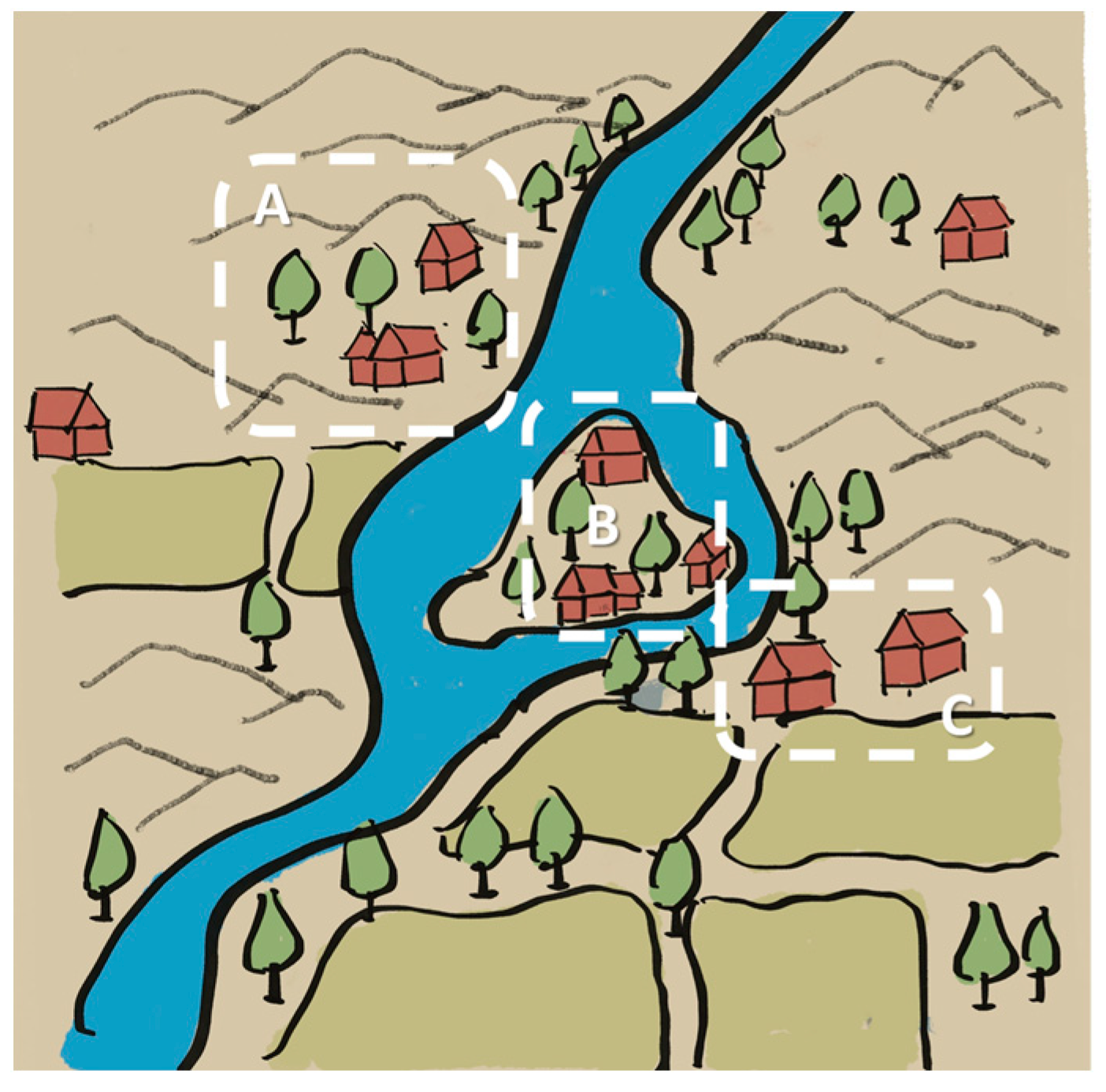

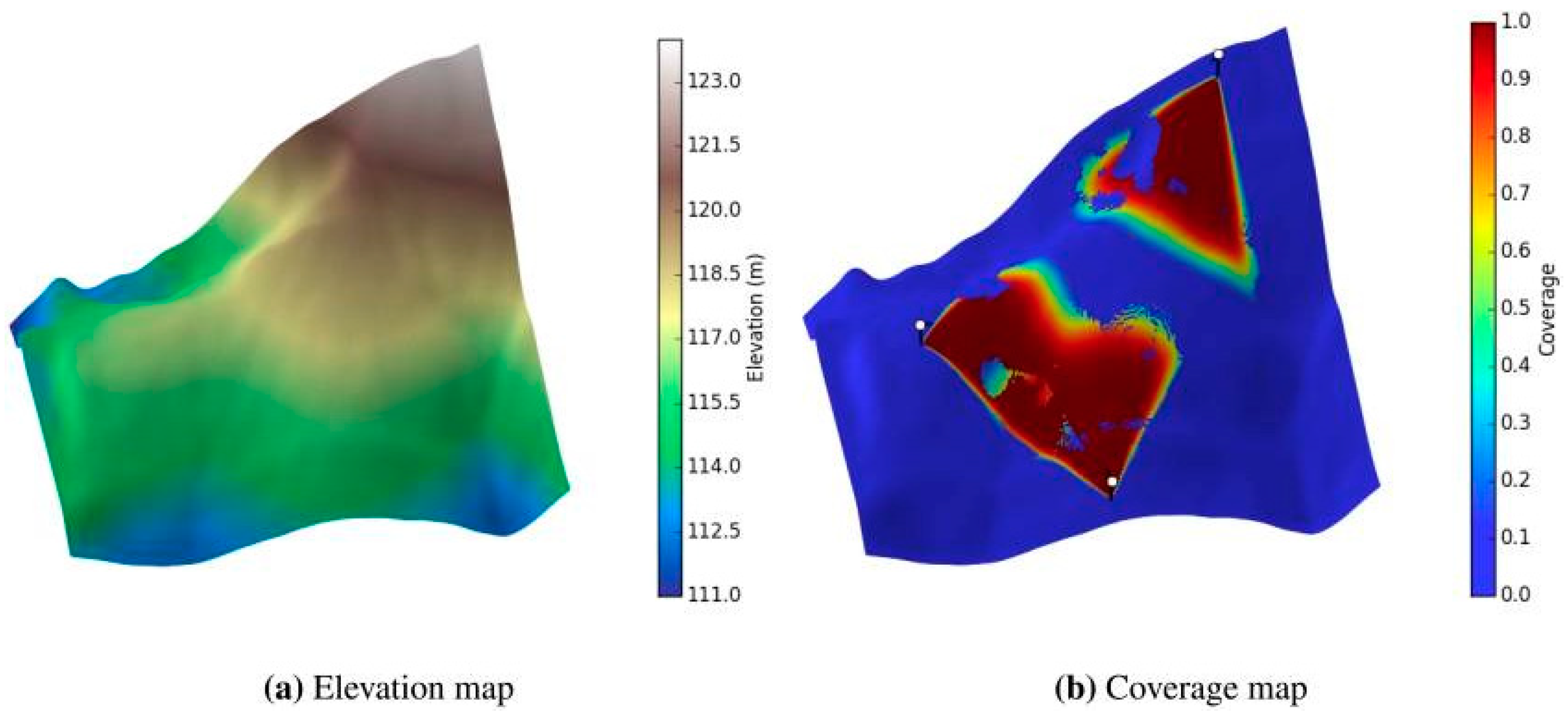
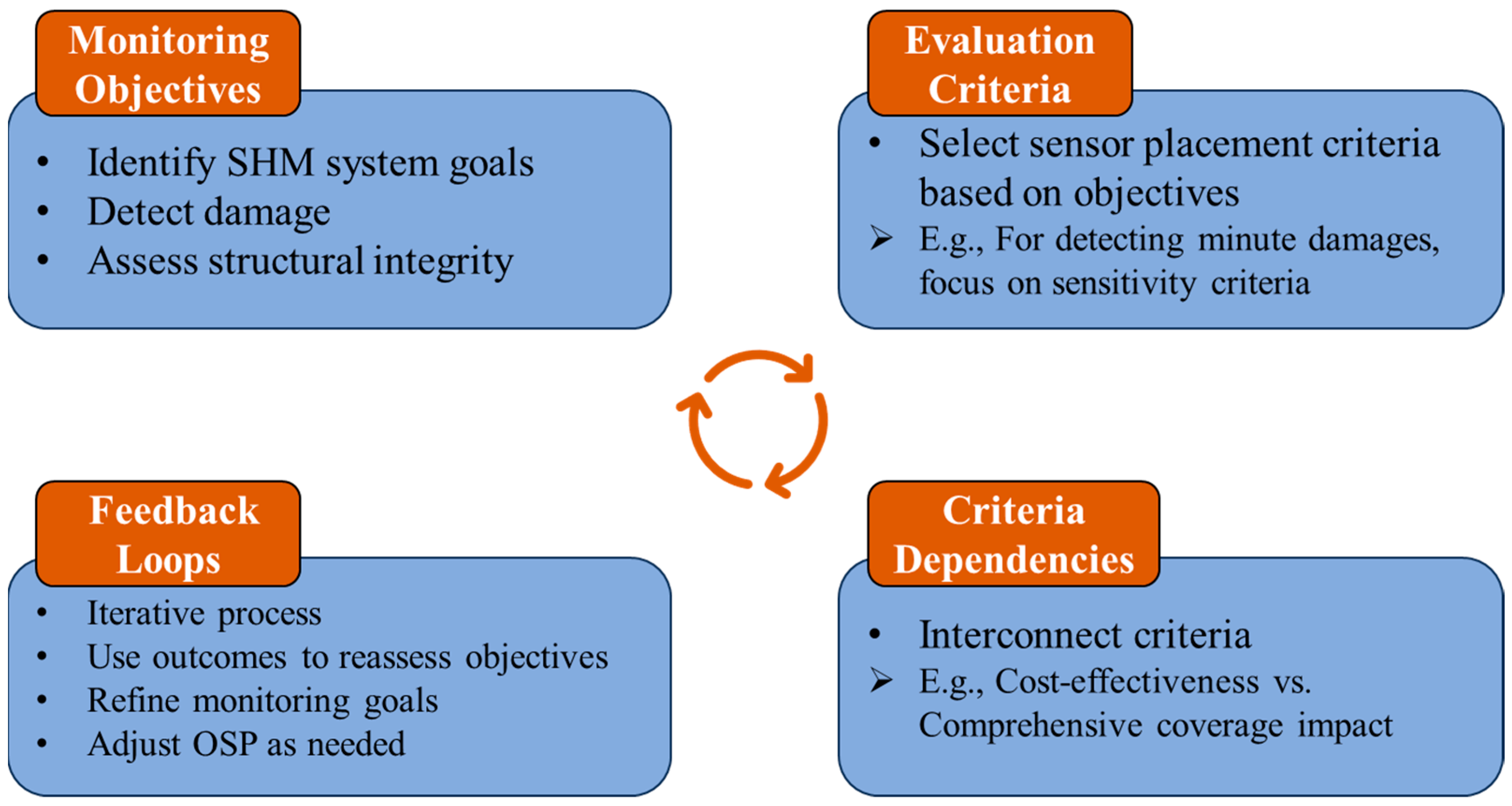
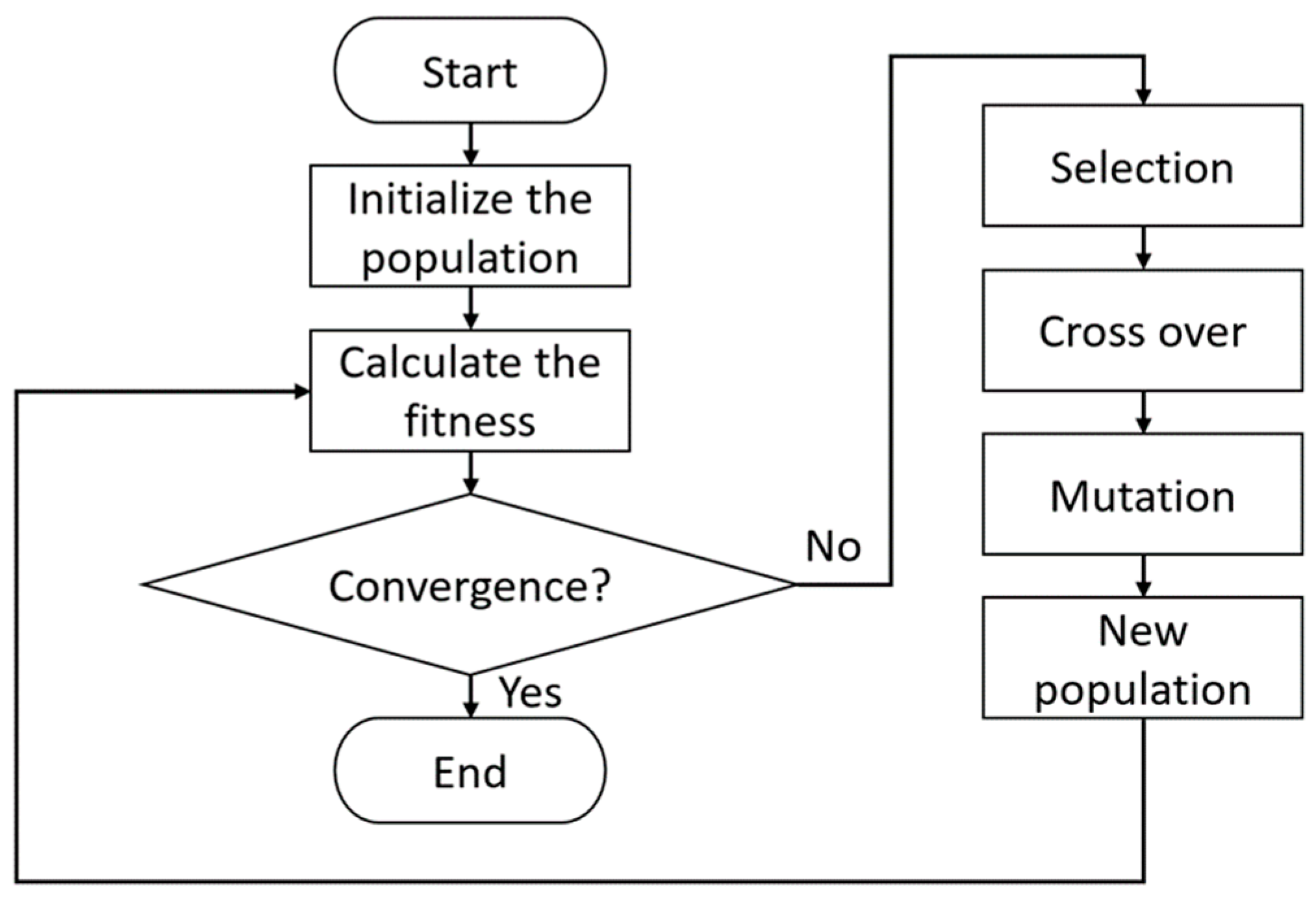

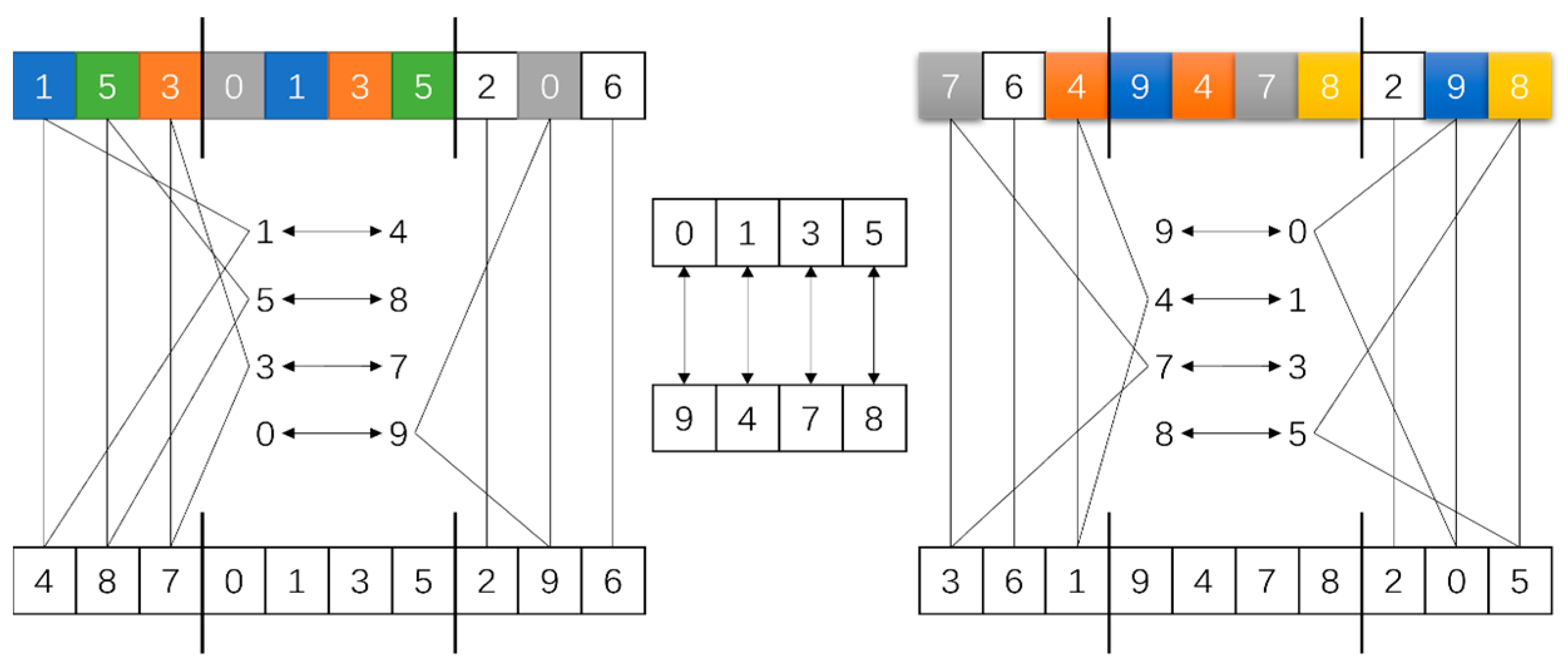
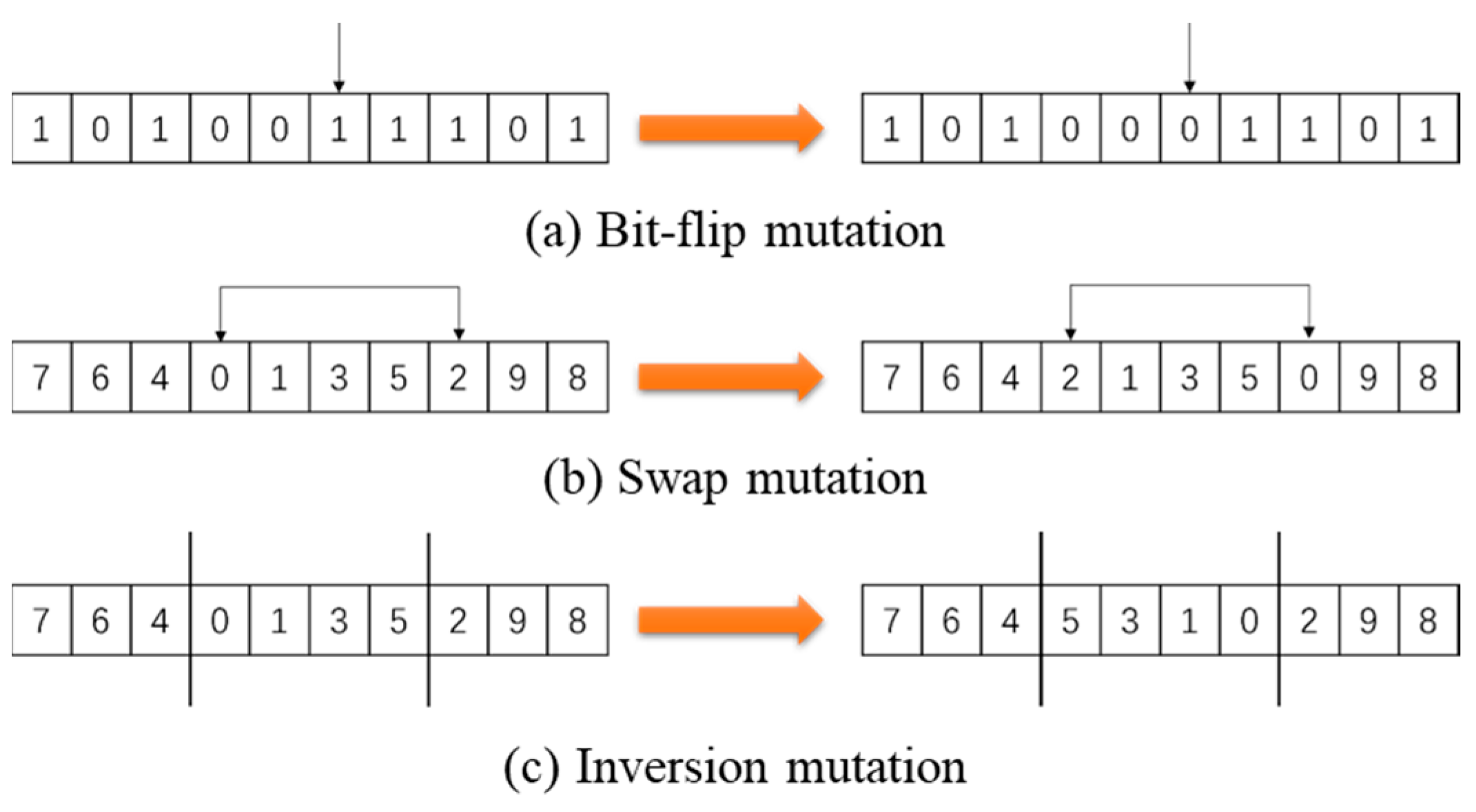
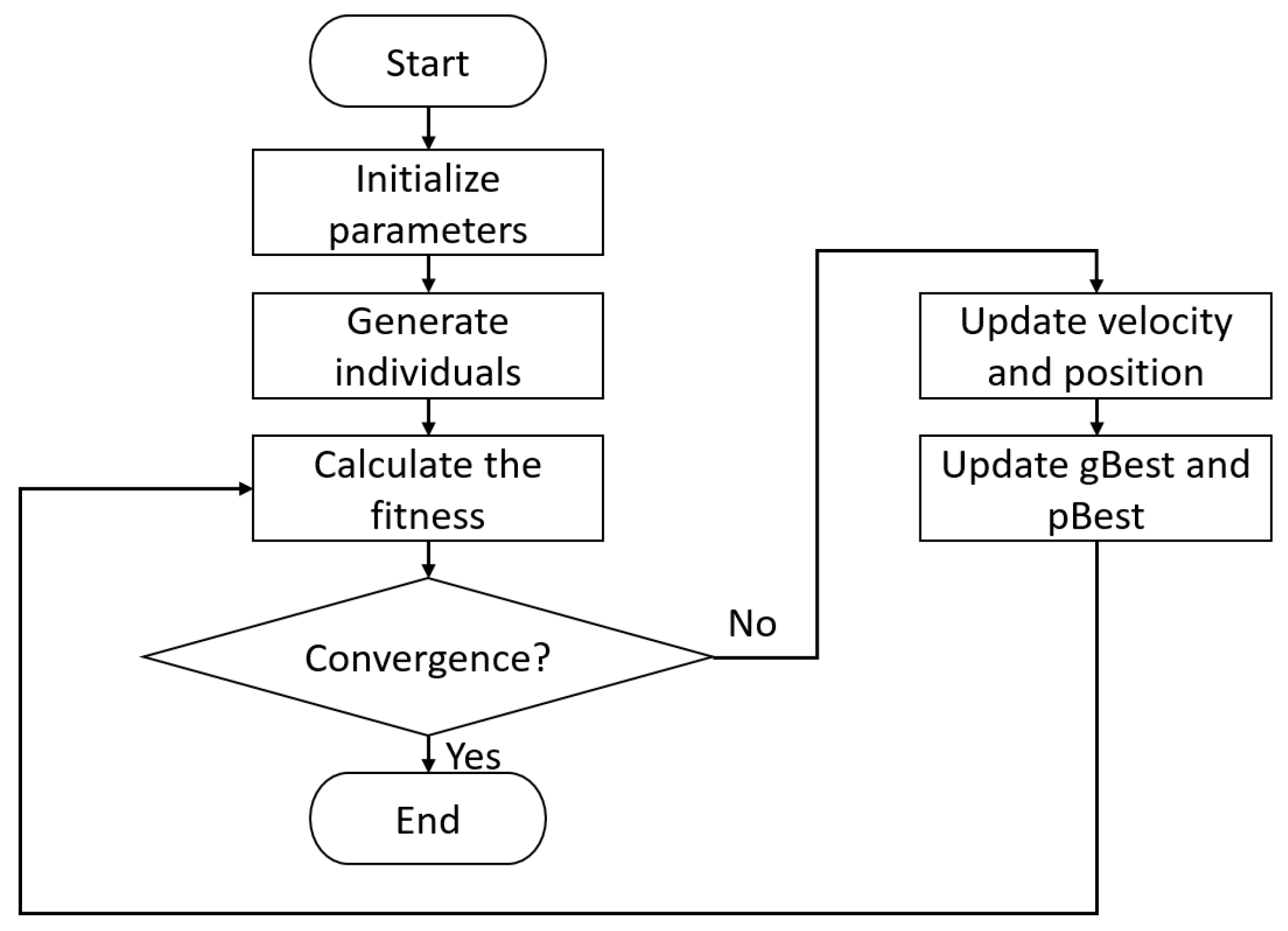
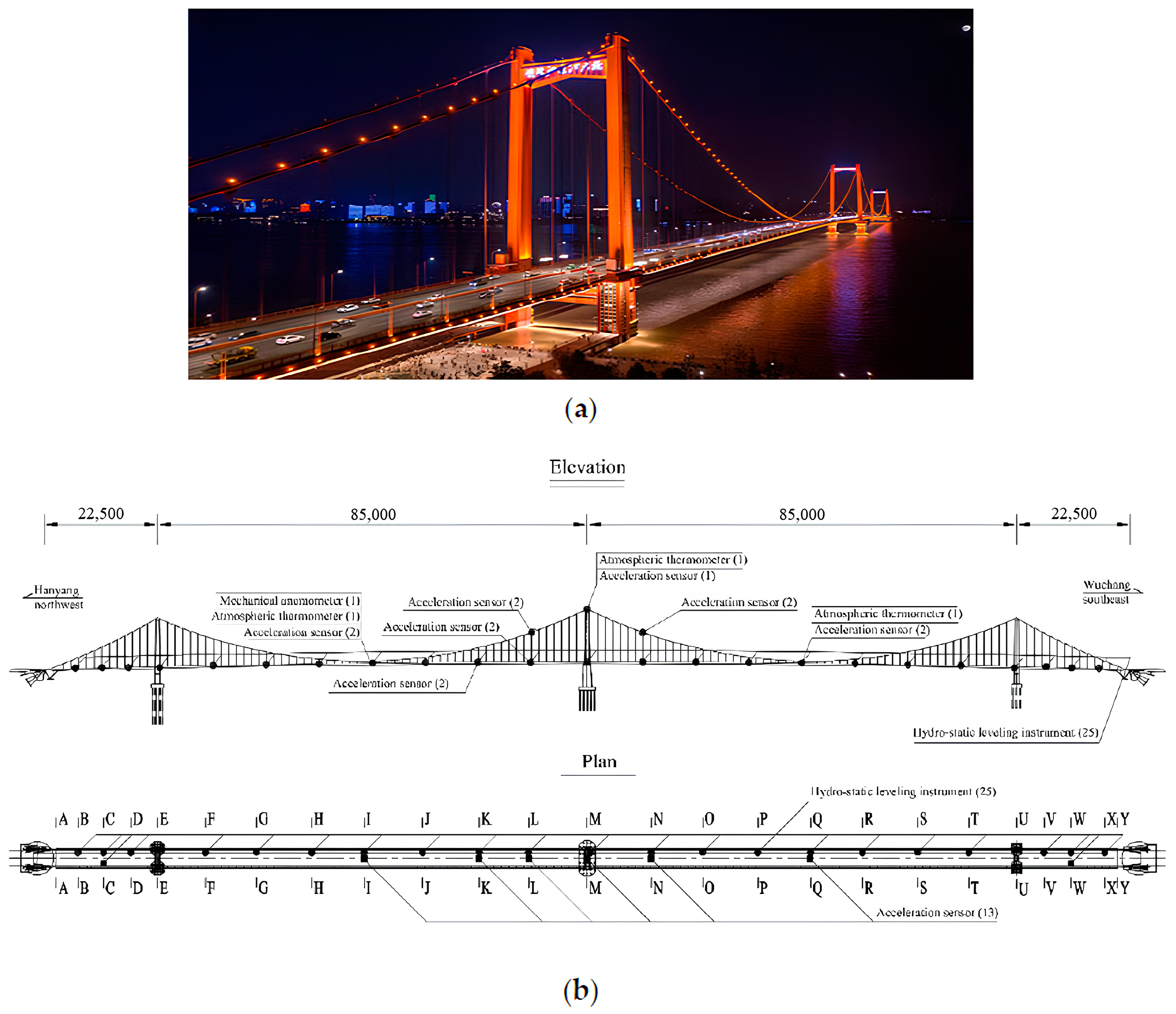
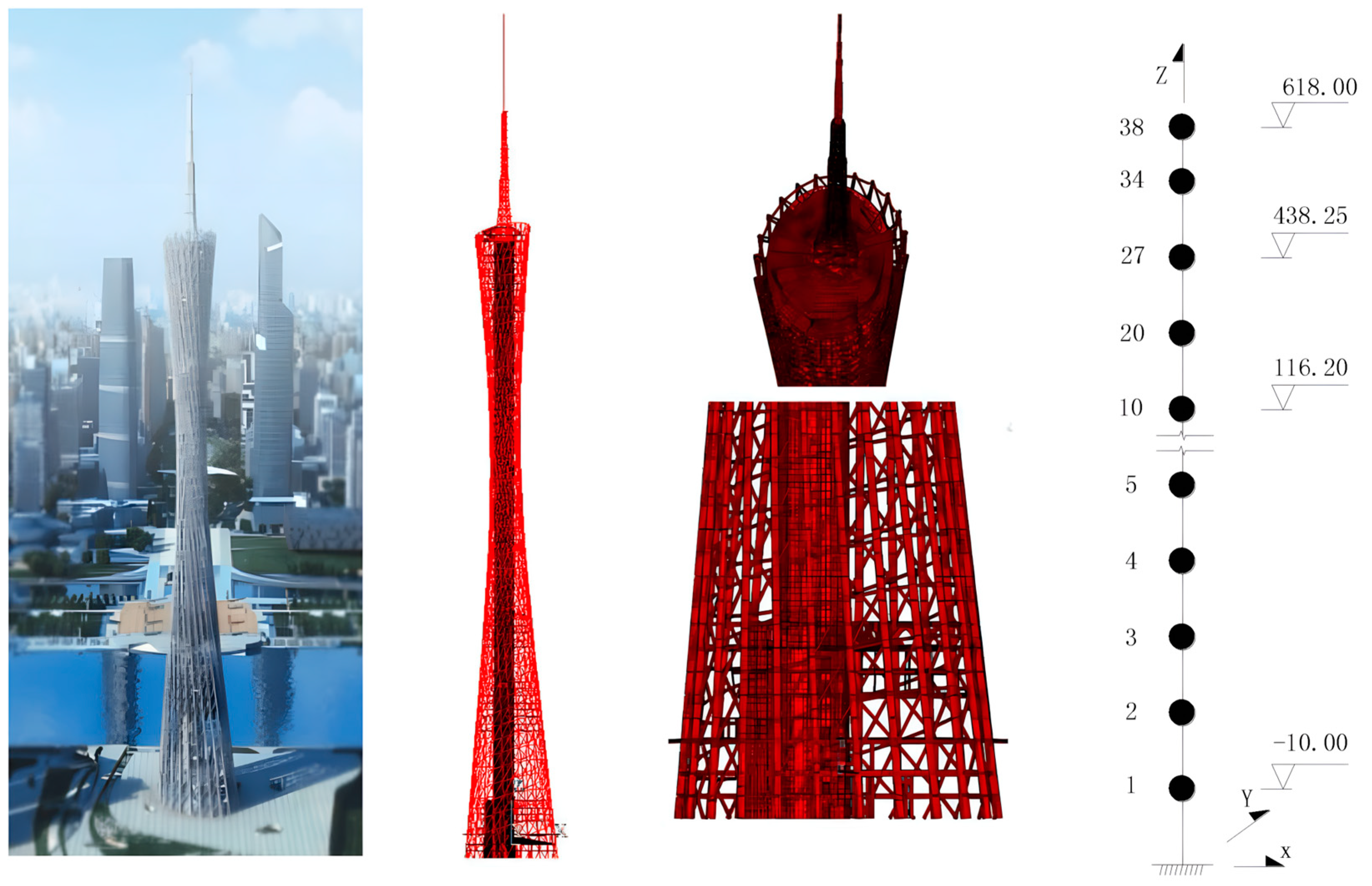

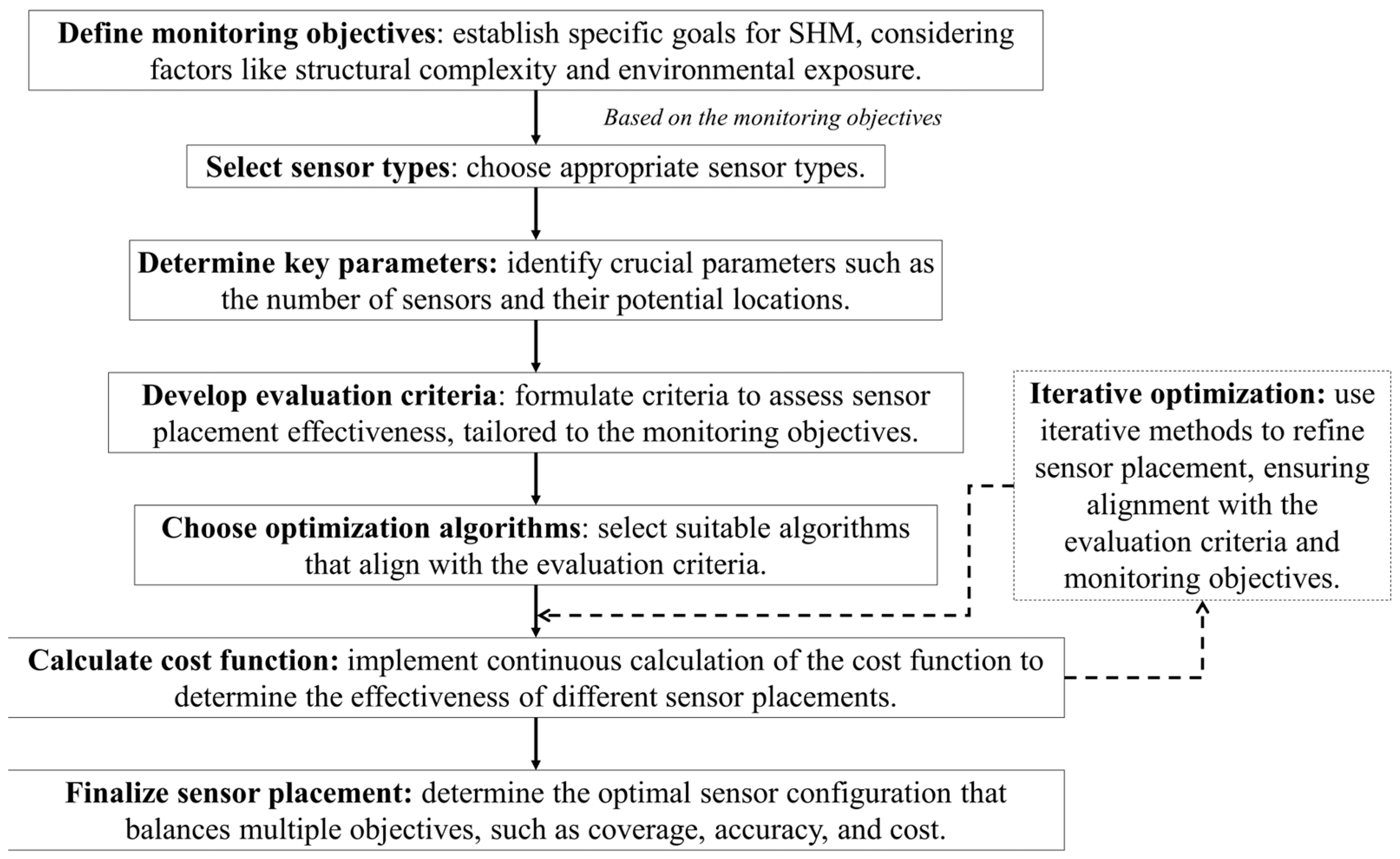
| Criterion | Description | Advantages | Disadvantages |
|---|---|---|---|
| Maximum Vibration Signal | Emphasis on high-intensity vibration signal acquisition. | Enhances signal clarity, pivotal for detecting significant structural changes. | Risk of neglecting subtle, yet crucial, structural signals. |
| Maximum Modal Identification | Optimization towards comprehensive modal information capture. | Facilitates in-depth analysis of structural dynamics. | Involves high computational resource allocation and complexity. |
| Minimum Parameter Identification Error | Precise estimation of structural parameters. | Increases reliability and accuracy in structural assessments. | Necessitates advanced computational algorithms, elevating operational intricacy. |
| Data Reconstruction Error Minimization | Aimed at high fidelity in data interpretation and reconstruction. | Ensures integrity and reliability of the data reconstruction process. | Computationally demanding, requiring sophisticated data handling capabilities. |
| Probability-Based Damage Detection | Utilizes probabilistic methods for early structural damage detection. | Facilitates early intervention and nuanced understanding of damage probabilities. | May yield non-definitive results due to inherent probabilistic nature. |
| Minimum Energy Consumption | Focus on energy-efficient sensor placement and functioning. | Promotes sustainable and cost-effective monitoring, especially long term. | Could limit data collection scope in energy-constrained setups. |
| Type of Algorithm | Features | Advantages | Disadvantages |
|---|---|---|---|
| Deterministic Sensor Placement |
| Emphasizes data precision and algorithmic speed. | Not well-adapted for large-scale or highly complex structures due to scalability limitations. |
| Sequential Sensor Placement |
| Focuses on the comprehensiveness of coverage and the number of iterations required for convergence. | Computationally demanding for extensive structures, potentially leading to increased time and resource consumption. |
| Meta-heuristic Optimization |
| Assesses the optimization of sensor network coverage and overall computational efficiency. | Can be computationally intensive and may require extensive calibration and fine-tuning to achieve optimal results. |
Disclaimer/Publisher’s Note: The statements, opinions and data contained in all publications are solely those of the individual author(s) and contributor(s) and not of MDPI and/or the editor(s). MDPI and/or the editor(s) disclaim responsibility for any injury to people or property resulting from any ideas, methods, instructions or products referred to in the content. |
© 2023 by the authors. Licensee MDPI, Basel, Switzerland. This article is an open access article distributed under the terms and conditions of the Creative Commons Attribution (CC BY) license (https://creativecommons.org/licenses/by/4.0/).
Share and Cite
Wang, Y.; Chen, Y.; Yao, Y.; Ou, J. Advancements in Optimal Sensor Placement for Enhanced Structural Health Monitoring: Current Insights and Future Prospects. Buildings 2023, 13, 3129. https://doi.org/10.3390/buildings13123129
Wang Y, Chen Y, Yao Y, Ou J. Advancements in Optimal Sensor Placement for Enhanced Structural Health Monitoring: Current Insights and Future Prospects. Buildings. 2023; 13(12):3129. https://doi.org/10.3390/buildings13123129
Chicago/Turabian StyleWang, Ying, Yue Chen, Yuhan Yao, and Jinping Ou. 2023. "Advancements in Optimal Sensor Placement for Enhanced Structural Health Monitoring: Current Insights and Future Prospects" Buildings 13, no. 12: 3129. https://doi.org/10.3390/buildings13123129
APA StyleWang, Y., Chen, Y., Yao, Y., & Ou, J. (2023). Advancements in Optimal Sensor Placement for Enhanced Structural Health Monitoring: Current Insights and Future Prospects. Buildings, 13(12), 3129. https://doi.org/10.3390/buildings13123129







